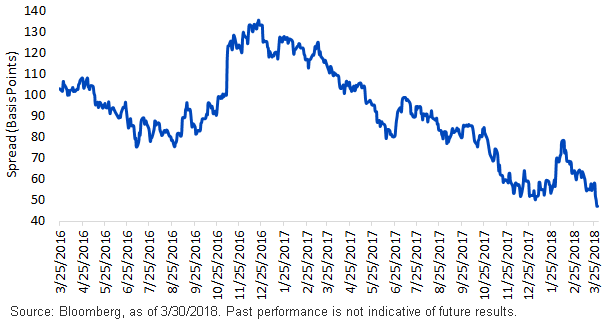If you had asked market participants what their expectations were for the U.S. Treasury (UST) yield curve (the difference in yield between the UST 10-Year and UST 2-Year notes) heading into 2018, 9 out of 10 would probably have said they expected the construct to continue to flatten. Well, how has this prognostication fared? The answer is rather surprising, so let's take a look at how things shaped up as Q1 came to a close.
The graph clearly illustrates the overarching trend since late 2016, which has been for the yield curve to flatten. To provide perspective, after hitting a peak reading of 136 basis points (bps) in late December of 2016, the differential between the UST 10-Year and the UST 2-Year yield started narrowing visibly, culminating in the low watermark of +50 bps to begin the current calendar year, the lowest level in more than 10 years.
U.S. Treasury 2-Year vs. 10-Year

Interestingly, what captivated investors' attention was really the move during the second half of last year. This flattening episode took the UST 2/10 spread from roughly +100 bps down to said low, essentially cutting the differential in half in only a six-month span. The catalyst behind this narrowing trend was the Federal Reserve's (Fed) monetary policy. As the FOMC raised rates in mid-June and then again in December, with the prospect of three additional hikes in 2018, the UST 2-Year yield was directly affected, rising almost 60 bps as a result. Meanwhile the UST 10-Year yield barely budged, increasing by a little less than 10 bps.
Then something unexpected happened between early January and mid-February of this year: the curve steepened. In this episode, investors witnessed the mirror image of what transpired during the second half of last year, as the UST 2-Year yield rose only a little more than 10 bps, while the UST 10-Year yield surged by over 40 bps. This produced a 2/10 spread of just under 80 bps. The disparity in rate movements earlier this year had more to do with recalibrating the yields for intermediate to longer-dated maturities, as the market began to discount the prospect for stronger economic growth, increasing budget deficits and attendant Treasury supply, and an inflation scare.



